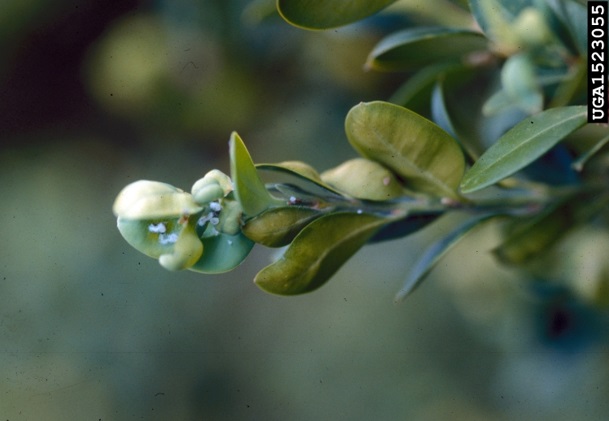Identifying Boxwood Psyllid
ENTFACT-454: Identifying Boxwood Psyllid | Download PDF
by Jonathan Larson, Extension Entomologist
University of Kentucky College of Agriculture
Fast Facts
- Boxwood psyllids are small pests and are considered “jumping plant lice” that suck juices from boxwoods they use as hosts.
- Psyllid feeding is concentrated in the newest growth at the tip of branches. The characteristic leaf cupping and curling usually starts appearing in early summer.
- The symptoms are mostly aesthetic, and treatment is usually not necessary. Simply pruning out the damaged areas can be the easiest solution.
Figure 1: Boxwood psyllids are small pests that affect the aesthetics of boxwood shrubs. They feed in the tender new growth, causing cupped leaves. They can also have a white coating as seen here. (Photo: Dan Herms, Bugwood.org)
Potential Hosts
Boxwood psyllids feed on members of the genus Buxus. This includes the commonly grown American and English boxwoods that are used for landscape and ornamental purposes.
Symptoms and Pest Description
The most obvious symptom of a boxwood psyllid infestation is the curling and cupping of leaves on the terminal and/or lateral buds of the shrub. As the psyllid develops, their feeding causes the leaves to curl and eventually cup together. Inside of these “cups” you can find developing nymphs and other symptoms, such as honeydew.
Figure 2: Boxwood psyllid nymphs are small and light green. They often have a white, waxy, fluff on portions of their body. They can be found by peeling apart the cupped together leaves. (Photo: Nancy Gregory, University of Delaware, Bugwood.org)
Boxwood psyllid eggs are tiny and orange. Nymphs that hatch out from the eggs are light green and small. Psyllids vaguely resemble planthoppers and cicadas. Immature psyllids may be partially coated with a white, cottony “fluff”. Adult boxwood psyllids are about 1/16th of inch long and light green. They also have clear wings and jumping legs that can help with hopping.
Life Cycle in Kentucky
There is only one generation of this pest per year in Kentucky. Boxwood psyllids typically overwinter in the egg stage, other states report they can overwinter as first instar nymphs hidden inside of their spent eggshells as well. The eggs hatch and nymphs emerge as boxwood buds begin expanding in the spring.
The new nymphs begin feeding on the expanding boxwood foliage which will induce the leaves to cup as they grow. By the end of May or the start of June, the nymphs will have matured to adulthood and mating will begin. Females will lay their eggs under bud scales on the boxwoods, where the eggs will remain until the next spring.
Management
It is rare that management is needed for boxwood psyllid. The damage caused is aesthetic and therefore can either be tolerated or simply pruned out. If you do prune out cupped leaf areas, be sure to do this by mid-May, before the insects reach adulthood and to destroy the debris you remove.
In some situations where the population has gotten out of hand or the boxwoods in question need to be maintained at a high level, there are insecticidal options. Organically, you can treat emerging buds in the spring with products like insecticidal soaps or summer versions of horticultural oil. Follow up the initial application with an inspection for nymphs and cupped leaves to ensure a second application is or is not necessary.
Contact insecticides also offer management for immatures as well as egg-laying adults. Spinosad is an organic option while synthetic insecticides like cyfluthrin, permethrin, bifenthrin, and cyhalothrin are other possible tools. These products would either be applied in early to mid-May to manage nymphs or by early June to intercept egg-laying adults (thus preventing some damage from happening the next year).
The final option would be applications of systemic insecticides. Dinotefuran and imidacloprid may be applied as a soil drench and the shrub will then transfer the product from the root-zone to the rest of the plant. This type of application must be made before damage occurs to the plant. This means treating in April or the start of May for most seasons. If you choose to use these systemic neonicotinoid insecticides, you need to monitor the shrub for potential mite issues that may occur later. These products have been associated with mite outbreaks in the past.
Issued: 5/11
Revised 01/22
CAUTION! Pesticide recommendations in this publication are registered for use in Kentucky, USA ONLY! The use of some products may not be legal in your state or country. Please check with your local county agent or regulatory official before using any pesticide mentioned in this publication.
Of course, ALWAYS READ AND FOLLOW LABEL DIRECTIONS FOR SAFE USE OF ANY PESTICIDE!
Images: University of Kentucky Entomology unless otherwise indicated


